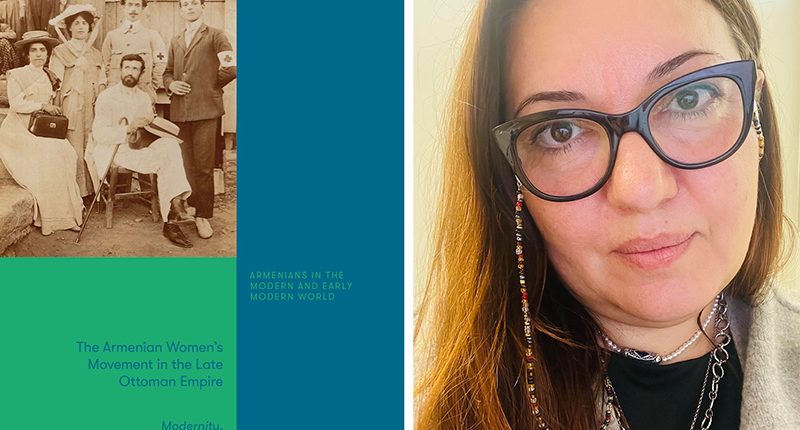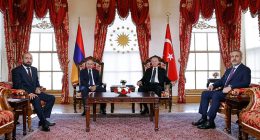LONDON/NEW YORK—I. B. Tauris, an imprint of Bloomsbury Publishing, has announced the publication of Dr. Hasmik Khalapyan’s The Armenian Women’s Movement in the Late Ottoman Empire: Modernity, Nationalism and Gender. The book is part of the series Armenians in the Modern and Early Modern World edited by Bedross Der Matossian (University of Nebraska, Lincoln).
The last decades of the Ottoman Empire saw heated debates about and changes to the role of women in society. This book analyses the history of the women’s movement among Ottoman Armenians. Examining debates on the role of women in the Armenian context, Armenian women’s access to education, work and marriage rights, it reveals how women were empowered by nationalist discourses and the wider movement for reform in the empire, and the ways these limited or broadened women’s activism. Drawing from a wide array of archival primary source material, it provides a comprehensive and comparative analysis of changes to the socio-economic, political, cultural status of Ottoman Armenian women from end of the Tanzimat period to the outbreak of World War I.
Khalapyan commented on the book, saying, “I am very happy that my research project of many years has materialized in this volume. Women’s history has been an essential part of global scholarship for many years, and I am thrilled that this book, dedicated to the history of the Armenian women’s movement in the Ottoman Empire, will find its place within that broader body of global women’s history.”
According to Khalapyan, the Armenian women’s movement in the late Ottoman Empire emerged as a complex interplay between national, imperial, and European forces, where women both shaped and were shaped by the evolving nationalist and modernist ideals of their time. Amid the debates surrounding the “New Nation” and the cultural, legal, economic, and social transformations sweeping the Empire, Khalapyan illustrates how women navigated the tension between tradition and modernity, actively contributing to nationalist projects. They did so not only by advocating for their rights within existing reforms but also by forging new pathways in education, social work, employment, and family structures.
“It has been my intention to show that women’s activism was inextricably tied to both local and global contexts, marked by the push and pull of European influence, Ottoman policies, and the national aspirations of the Armenian people,” she said. She continued, “Through a nuanced examination of these intersecting forces presented in the book, I hope my readers will see the multifaceted nature of Armenian modernity and gain a richer understanding of the complex dynamics that shaped the Armenian community and the women who played pivotal roles in its transformation.”
“This is an outstanding study of the history of the Armenian women’s movement in the Ottoman Empire, a topic that has long remained marginalized,” said Der Matossian, editor of the series. “Khalapyan has successfully woven the history of the movement by situating it within the global, regional, and local contexts of women’s movements.”
Reviews
“Khalapyan’s examination of Armenian feminist writers narrates the intertwined histories of Ottoman Turks and Armenians. The writers she taps across five languages were central to the rise of Armenian national consciousness in the late Ottoman Empire. A much-needed manuscript in the field, it situates Ottoman Armenian feminism within the broader global movements for women’s liberation.”― Elyse Semerdjian, Professor, Clark University, US
“Meticulously researched through Armenian, Turkish, French and Russian sources, this most impressive book traces the historical emergence of the Armenian women’s movement by triangulating Europe (modernity), the Ottoman Empire (imperial state), and its colonial subjects (Armenian community). The empirical focus on local dynamics reveals three endeavors that actualize the new emerging Armenian womanhood: i) taking care of the nation through organized charity and education; ii) campaigning for paid labor and a job market for women; iii) improving marriage and the family. Theoretically, the author cogently demonstrates how social movements negotiate local, national and global conditions and how women’s movements in particular undergird these negotiations. A must read for those interested in how women imperial subjects employ their agency to study the intersection of history, modernity, and empire as Ottoman Armenian women do.” ―Fatma Müge Göçek, Professor, University of Michigan, USA
“An important contribution to our understanding of the gender politics permitting Armenian feminists to navigate extremely troubled waters!” ―Suraiya Faroqhi, Professor, Ibn Haldun University, Turkey
Dr. Hasmik Khalapyan is an Associate Professor at the American University of Armenia (AUA), specializing in Ottoman history, the history of social and labor movements, and women’s history. Her scholarly work has been published in esteemed international journals and edited volumes, with translations in both Western Armenian and Turkish.
Copies of The Armenian Women’s Movement in the Late Ottoman Empire: Modernity, Nationalism and Gender are available for purchase from the Bloomsbury Press website. Enter code GLR AT8 at the checkout on bloomsbury.com for 35% off.










